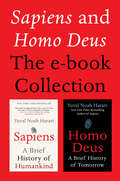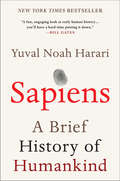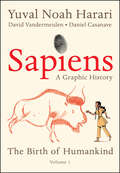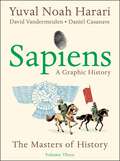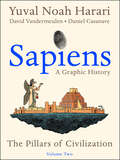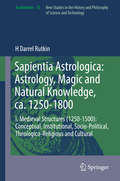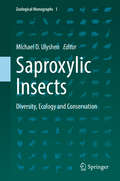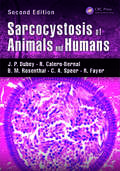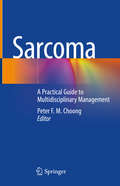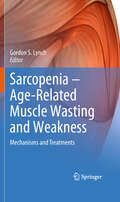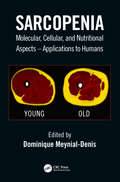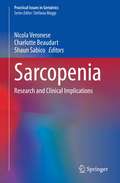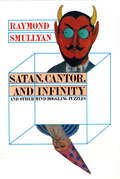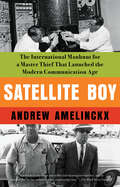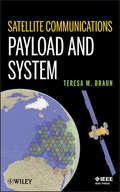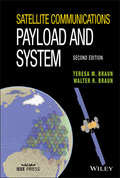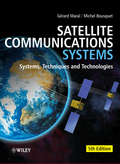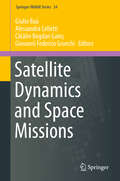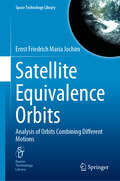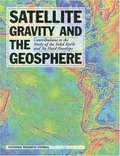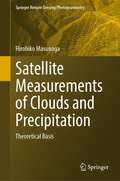- Table View
- List View
Sapiens and Homo Deus: A Brief History of Humankind and A Brief History of Tomorrow
by Yuval Noah HarariDiscover humanity’s past and its future in this in this special e-book collection featuring Sapiens—a reading pick of President Barack Obama, Bill Gates, and Mark Zuckerberg—and its acclaimed companion Homo Deus.
Sapiens: A Brief History of Humankind (Patterns Of Life Ser.)
by Yuval Noah HarariNew York Times Readers’ Pick: Top 100 Books of the 21st CenturyNew York Times BestsellerA Summer Reading Pick for President Barack Obama, Bill Gates, and Mark Zuckerberg From a renowned historian comes a groundbreaking narrative of humanity’s creation and evolution—a #1 international bestseller—that explores the ways in which biology and history have defined us and enhanced our understanding of what it means to be “human.”One hundred thousand years ago, at least six different species of humans inhabited Earth. Yet today there is only one—homo sapiens. What happened to the others? And what may happen to us?Most books about the history of humanity pursue either a historical or a biological approach, but Dr. Yuval Noah Harari breaks the mold with this highly original book that begins about 70,000 years ago with the appearance of modern cognition. From examining the role evolving humans have played in the global ecosystem to charting the rise of empires, Sapiens integrates history and science to reconsider accepted narratives, connect past developments with contemporary concerns, and examine specific events within the context of larger ideas.Dr. Harari also compels us to look ahead, because over the last few decades humans have begun to bend laws of natural selection that have governed life for the past four billion years. We are acquiring the ability to design not only the world around us, but also ourselves. Where is this leading us, and what do we want to become?Featuring 27 photographs, 6 maps, and 25 illustrations/diagrams, this provocative and insightful work is sure to spark debate and is essential reading for aficionados of Jared Diamond, James Gleick, Matt Ridley, Robert Wright, and Sharon Moalem.
Sapiens: The Birth of Humankind (Vol. 1)
by Yuval Noah HarariThe ebook is designed to be read on devices with large color displaysThe Kindle edition is incompatible with iOS. See below for a list of supported devices.New York Times BestsellerThe first volume of the graphic adaptation of Yuval Noah Harari's smash #1 New York Times and international bestseller recommended by President Barack Obama and Bill Gates, with gorgeous full-color illustrations and concise, easy to comprehend text for adult and young adult readers alike.One hundred thousand years ago, at least six different species of humans inhabited Earth. Yet today there is only one—homo sapiens. What happened to the others? And what may happen to us?In this first volume of the full-color illustrated adaptation of his groundbreaking book, renowned historian Yuval Harari tells the story of humankind’s creation and evolution, exploring the ways in which biology and history have defined us and enhanced our understanding of what it means to be “human.” From examining the role evolving humans have played in the global ecosystem to charting the rise of empires, Sapiens challenges us to reconsider accepted beliefs, connect past developments with contemporary concerns, and view specific events within the context of larger ideas. Featuring 256 pages of full-color illustrations and easy-to-understand text covering the first part of the full-length original edition, this adaptation of the mind-expanding book furthers the ongoing conversation as it introduces Harari’s ideas to a wide new readership.
Sapiens: The Masters of History
by Yuval Noah HarariThis third volume of the illustrated adaptation of the internationally bestselling phenomenon, Sapiens: A Graphic History—The Masters of History, tackles the question of the driving force of humanity’s fate: is it empire, money, religion—or something else entirely—that unites us?Sometimes history seems like a laundry list of malevolent monarchs, pompous presidents and dastardly dictators. But are they really the ones in the driving seat? Sapiens: A Graphic History—The Masters of History takes us on an immersive and hilarious ride through the human past to discover the forces that change our world, bring us together, and just as often... tear us apart.Grab a front-row seat to the greatest show on earth, and explore the rise of money, religion and empire. Join our fabulous host Heroda Tush, as she wonders: Which historical superhero will display the power to make civilizations rise and fall? Will Mr. Random prove that luck and circumstance prevail? Will Lady Empire convince us of the irrefutable shaping force of conquerors? Or will Clashwoman beat them all to greatness by reminding us of the endless confrontations that seem to forever plague our species?In this next volume of the bestselling graphic series, Yuval Noah Harari, David Vandermeulen and Daniel Casanave continue to present the complicated story of humankind with wit, empathy and originality. Alongside the unlikely cast of new characters, we are rejoined by the familiar faces of Yuval, Zoe, Professor Saraswati, Bill and Cindy (now Romans), Skyman and Captain Dollar. As they travel through time, space and human drama in search of truth, it's impossible not to wonder: why can’t we all just get along?This third installment in the Sapiens: A Graphic History series is an engaging, insightful, and colorful retelling of the story of humankind for curious minds of all ages, and can be browsed through on its own or read in sequence with Volumes One and Two.
Sapiens: The Pillars of Civilization (Sapiens: A Graphic History #2)
by Yuval Noah HarariThe ebook is designed to be read on devices with large color displaysThe Kindle edition is incompatible with iOS. See below for a list of supported devices.This second volume of Sapiens: A Graphic History, the full-color graphic adaptation of Yuval Noah Harari’s #1 New York Times bestseller, focuses on the Agricultural Revolution—when humans fell into a trap we’ve yet to escape: working harder and harder with diminishing returns.What if humanity’s major woes—war, plague, famine and inequality—originated 12,000 years ago, when Homo sapiens converted from nomads to settlers, in pursuit of the fantasy of productivity and efficiency? What if by seeking to control plants and animals, humans ended up being controlled by kings, priests, and Kafkaesque bureaucracy? Volume 2 of Sapiens: A Graphic History–The Pillars of Civilization explores a crucial chapter in human development: the Agricultural Revolution. This is the story of how wheat took over the world; how an unlikely marriage between a god and a bureaucrat created the first empires; and how war, plague, famine, and inequality became an intractable feature of the human condition.But it’s not all doom and gloom with this book’s cast of entertaining characters and colorful humorous scenes. Yuval, Zoe, Prof. Saraswati, Cindy and Bill (now farmers), Detective Lopez, and Dr. Fiction, all introduced in Volume 1, once again travel the length and breadth of human history, this time investigating the impact the Agricultural Revolution has had on our species. The cunning Mephisto shows them how to ensnare humans, King Hammurabi lays down the law, and Confucius explains harmonious society. The origins of modern farming are introduced through Elizabethan tragedy; the changing fortunes of domesticated plants and animals are tracked in the columns of the Daily Business News; the story of urbanization is portrayed as a travel brochure, offering discount journeys to ancient Babylon and China; and the history of inequality unfolds in a superhero detective story; with guest appearances by historical and cultural personalities throughout such as Thomas Jefferson, Scarlett O'Hara, Margaret Thatcher, and John Lennon.Sapiens: A Graphic History, Volume 2 is a radical, witty and colorful retelling of the story of humankind for adults and young adults, and can be read on its own or in sequence with Volume I.
Sapientia Astrologica: I. Medieval Structures (1250-1500): Conceptual, Institutional, Socio-Political, Theologico-Religious and Cultural (Archimedes #55)
by H Darrel RutkinThis book explores the changing perspective of astrology from the Middle Ages to the Early Modern Era. It introduces a framework for understanding both its former centrality and its later removal from legitimate knowledge and practice. The discussion reconstructs the changing roles of astrology in Western science, theology, and culture from 1250 to 1500. The author considers both the how and the why. He analyzes and integrates a broad range of sources. This analysis shows that the history of astrology—in particular, the story of the protracted criticism and ultimate removal of astrology from the realm of legitimate knowledge and practice—is crucial for fully understanding the transition from premodern Aristotelian-Ptolemaic natural philosophy to modern Newtonian science. This removal, the author argues, was neither obvious nor unproblematic. Astrology was not some sort of magical nebulous hodge-podge of beliefs. Rather, astrology emerged in the 13th century as a richly mathematical system that served to integrate astronomy and natural philosophy, precisely the aim of the “New Science” of the 17th century. As such, it becomes a fundamentally important historical question to determine why this promising astrological synthesis was rejected in favor of a rather different mathematical natural philosophy—and one with a very different causal structure than Aristotle's.
Saproxylic Insects: Diversity, Ecology And Conservation (Zoological Monographs #1)
by Michael D. UlyshenThis volume offers extensive information on insect life in dying and dead wood. Written and reviewed by leading experts from around the world, the twenty-five chapters included here provide the most global coverage possible and specifically address less-studied taxa and topics. An overarching goal of this work is to unite literature that has become fragmented along taxonomic and geographic lines. A particular effort was made to recognize the dominant roles that social insects (e.g., termites, ants and passalid beetles) play in saproxylic assemblages in many parts of the world without overlooking the non-social members of these communities.The book is divided into four parts:· Part I “Diversity” includes chapters addressing the major orders of saproxylic insects (Coleoptera, Diptera, Hymenoptera, Hemiptera, Lepidoptera and Blattodea), broadly organized in decreasing order of estimated global saproxylic diversity. In addition to order-level treatments, some chapters in this part discuss groups of particular interest, including pollinators, hymenopteran parasitoids, ants, stag and passalid beetles, and wood-feeding termites.· Part II “Ecology” discusses insect-fungal and insect-insect interactions, nutritional ecology, dispersal, seasonality, and vertical stratification.· Part III “Conservation” focuses on the importance of primary forests for saproxylic insects, offers recommendations for conserving these organisms in managed forests, discusses the relationships between saproxylic insects and fire, and addresses the value of tree hollows and highly-decomposed wood for saproxylic insects. Utilization of non-native wood by saproxylic insects and the suitability of urban environments for these organisms are also covered.· Lastly, Part IV “Methodological Advancements” highlights molecular tools for assessing saproxylic diversity. The book offers an accessible and insightful resource for natural historians of all kinds and will especially appeal to entomologists, ecologists, conservationists and foresters.
Sarah and the Big Wave: The True Story of the First Woman to Surf Mavericks
by Bonnie TsuiThis stunning nonfiction picture book tells the inspiring story of Sarah Gerhardt, one of the first female big-wave surfers. Have you ever seen a big wave? One that’s twenty, thirty, forty, even fifty feet tall? Here’s a better question: Would you ever surf a big wave? Sarah Gerhardt did—and this is her story.Sarah and the Big Wave, a tale of perseverance and indomitable spirit, is about the first woman to ride the waves at Mavericks, one of the biggest and most dangerous surf breaks in the world.
Sarcocystosis of Animals and Humans
by J. P. Dubey R. Calero-Bernal B.M. Rosenthal C.A. Speer R. FayerSarcocystis is one of the most prevalent parasites of livestock and also infects many wild mammals, birds, and humans. Written by the authors who pioneered studies of Sarcocystosis of domestic animals, Sarcocystosis of Animals and Humans, Second Edition provides a current and comprehensive review of Sarcocystis and the infections it causes in anima
Sarcoma: A Practical Guide to Multidisciplinary Management
by Peter F. M. ChoongThis book aims to compile an expert text on the multidisciplinary approach to treating sarcoma at a sarcoma centre. Separate chapters and sections highlight the specialist diagnostic and therapeutic approaches employed in treating bone and soft tissue sarcoma. This comprehensive book covers sarcoma and its management across specialties. It brings together the experience of the editor at a major centre for sarcoma management in Australia along with chapter contributions from various experts on the topic. The real-life, pragmatic approach is a distillation of the evidence and intends to make much of what is written translatable. This book serves as a reference for managing this tumour type and as an indispensable guide for daily use across the spectrum of providers.
Sarcopenia – Age-Related Muscle Wasting and Weakness
by Gordon S. LynchSome of the most serious consequences of aging are its effects on skeletal muscle. 'Sarcopenia', the progressive age-related loss of muscle mass and associated muscle weakness, renders frail elders susceptible to serious injury from sudden falls and fractures and at risk for losing their functional independence. Not surprisingly, sarcopenia is a significant public health problem throughout the developed world. There is an urgent need to better understand the neuromuscular mechanisms underlying age-related muscle wasting and to develop therapeutic strategies that can attenuate, prevent, or ultimately reverse sarcopenia. Significant research and development in academic and research institutions and in pharmaceutical companies is being directed to sarcopenia and to related health issues in order to develop and evaluate novel therapeutics. This book provides the latest information on sarcopenia from leading international researchers studying the cellular and molecular mechanisms underlying age-related changes in skeletal muscle and identifies strategies to combat sarcopenia and related muscle wasting conditions and neuromuscular disorders. The book provides a vital resource for researchers and practitioners alike, with information relevant to gerontologists, geriatricians, sports medicine physicians, physiologists, neuroscientists, cell biologists, endocrinologists, physical therapists, allied health and musculoskeletal practitioners, strength and conditioning specialists, athletic trainers, and students of the medical and biomedical sciences.
Sarcopenia: Molecular, Cellular, and Nutritional Aspects
by Dominique Meynial-DenisSarcopenia: Molecular, Cellular, and Nutritional Aspects describes the progressive loss of skeletal muscle mass and strength, defined by Rosenberg in 1997 as a hallmark of aging and referred to as &“sarcopenia.&” As life expectancy continues to increase worldwide, sarcopenia has become a major public health issue. The condition worsens in the presence of chronic diseases accelerating its progression. Sarcopenia is not considered to be &“a process of normative aging&” but according to the International Classification of Disease, Tenth Revision, Clinical Modification (ICD-10-CM), as a disease. As sarcopenia is an ineluctable process, prevention and management are the only options to promote healthy aging; these actions should perhaps be taken during youth. <p><p>Included in this book: <li>Features essential information on sarcopenia, its current definition, and molecular and cellular aspects of this disease <li>Discusses the development of physical frailty, a complication of sarcopenia, and predicts its occurrence in the older population <li>Presents alterations in muscle protein turnover and mitochondrial dysfunction in the aging process <li>Provides data on the negative involvement of sarcopenia in certain chronic diseases <li>Describes presbyphagia or age-related changes in the swallowing mechanism in older people <li>Details possible strategies to combat muscle wasting in healthy older adults and their limits <p><p>This book features information collected from pioneers or experts on human aging from around the globe, including Europe, Brazil, Canada, Japan and the United States. It is a valuable source of information for nutritional scientists, medical doctors, sports scientists, food scientists, dietitians, students in these fields, and for anyone interested in nutrition. We hope this book provides a better understanding of sarcopenia which inevitably occurs with aging without weight loss. Moreover, this book will supply information outlining strategies to prevent or limit muscle wasting due to normal aging in order to promote successful aging.
Sarcopenia: Research and Clinical Implications (Practical Issues in Geriatrics)
by Nicola Veronese Charlotte Beaudart Shaun SabicoThis book offers a concise and updated guide for all readers (physicians and non-physicians) interested in gaining a comprehensive and precise understanding of sarcopenia. Over the last several years, sarcopenia has increasingly developed from being a concept known only in research settings to one that is commonly explored in journals and scientific meetings for various disciplines, such as geriatrics, rheumatology and rehabilitation medicine. Thus, all domains of sarcopenia, from molecular aspects to clinical management, represent highly active areas of research and clinical practice for health professionals in a variety of fields, including geriatric medicine, nutrition, and epidemiology. Despite being a relatively new concept in medicine, sarcopenia is increasingly being recognized as an important determinant of other health conditions, including mortality and disability. This book, written by experts from around the globe, covers several core aspects of sarcopenia management, from molecular mechanisms to genetics, epidemiology, diagnosis and finally treatment, including the clinical impact of sarcopenia as a risk factor, the known genetic and molecular aspects that can aid in predicting sarcopenia, and selected treatment and therapy concepts, including indications for nutrition and physical exercise. Sharing data from the latest studies, it will be of considerable interest not only for geriatricians, but also for a wide range of other readers.
Satan, Cantor, And Infinity And Other Mind-bogglin
by Raymond M. SmullyanHonorable knights, lying knaves, and other fanciful characters populate this unusual survey of the principles underlying the works of Georg Cantor. Created by a renowned mathematician, these engaging puzzles apply logical precepts to issues of infinity, probability, time, and change. They require a strong mathematics background and feature complete solutions.
Satellite Boy: The International Manhunt for a Master Thief That Launched the Modern Communication Age
by ANDREW AMELINCKXSpanning the underworld haunts of Montreal to Havana and Miami in the early days of the Cold War, Satellite Boy reveals the unlikely connection between an audacious bank heist and the &“other Space Race&” that gave birth to the modern communication ageOn April 6, 1965, Georges Lemay was relaxing on his yacht in a south Florida marina following one of the largest and most daring bank heists in Canadian history. For four years, the roguishly handsome criminal mastermind hid in plain sight, eluding capture and the combined efforts of the FBI, Interpol, and the Royal Canadian Mounted Police. His future appeared secure.What Lemay didn&’t know was that less than two hundred miles away at Cape Canaveral, a brilliant engineer named Harold Rosen was about to usher in the age of global live television with the launch of the world&’s first twenty-four-hour commercial communications satellite. Rosen&’s extraordinary accomplishment would not only derail Lemay&’s cushy life but change the world forever.Brimming with criminal panache and technological intrigue, and set against a turbulent and iconic period that includes the moon landing and the civil rights movement, Satellite Boy tells the largely forgotten, high-stakes story of the two equally driven men who inadvertently launched the modern era.
Satellite Communications
by Joseph N. PeltonThe field of satellite communications represents the world's largest space industry. Those who are interested in space need to understand the fundamentals of satellite communications, its technology, operation, business, economic, and regulatory aspects. This book explains all this along with key insights into the field's future growth trends and current strategic challenges. Fundamentals of Satellite Communications is a concise book that gives all of the key facts and figures as well as a strategic view of where this dynamic industry is going. Author Joseph N. Pelton, PhD, former Dean of the International Space University and former Director of Strategic Policy at Intelstat, presents a readable book about the entire essence of the satellite communication field.
Satellite Communications Payload and System
by Teresa M. BraunThis is the first book primarily about the satellite payload of satellite communications systems. It represents a unique combination of practical systems engineering and communications theory. It tells about the satellites in geostationary and low-earth orbits today, both the so-called bent-pipe payloads and the processing payloads. The on-orbit environment, mitigated by the spacecraft bus, is described. The payload units (e.g. antennas and amplifiers), as well as payload-integration elements (e.g. waveguide and switches) are discussed in regard to how they work, what they do to the signal, their technology, environment sensitivity, and specifications. At a higher level are discussions on the payload as an entity: architecture including redundancy; specifications--what they mean, how they relate to unit specifications, and how to verify; and specification-compliance analysis ("budgets") with uncertainty. Aspects of probability theory handy for calculating and using uncertainty and variation are presented. The highest-level discussions, on the end-to-end communications system, start with a practical introduction to physical-layer communications theory. Atmospheric effects and interference on the communications link are described. A chapter gives an example of optimizing a multibeam payload via probabilistic analysis. Finally, practical tips on system simulation and emulation are provided. The carrier frequencies treated are 1 GHz and above. Familiarity with Fourier analysis will enhance understanding of some topics. References are provided throughout the book for readers who want to dig deeper.Payload systems engineers, payload proposal writers, satellite-communications systems designers and analysts, and satellite customers will find that the book cuts their learning time. Spacecraft-bus systems engineers, payload unit engineers, and spacecraft operators will gain insight into the overall system. Students in systems engineering, microwave engineering, communications theory, probability theory, and communications simulation and modelling will find examples to supplement theoretical texts.
Satellite Communications Payload and System (Wiley - IEEE)
by Teresa M. Braun Walter R. BraunSATELLITE COMMUNICATIONS PAYLOAD AND SYSTEM A valuable reference on communications satellite systemsThis book presents the state of the art in commercial communications satellite systems, thoroughly and in detail not to be found in any other book. These systems provide the television and some of the telephone and Internet services in use every day. The book focuses on the satellite payload, which consists of antennas, receivers, and transmitters. The book discusses the what, the how, and the why of various choices that have been made in currently operating systems.The book is organized into three parts:In-depth description of various payload units, not requiring specialist knowledge. For each unit and the payload as a whole, the architectures, the theory of operation, analysis, performance, and specifications are presented.End-to-end system context in which the payload operates. Digital communications theory and satellite communications protocols are introduced. The time-varying properties of satellite-to-ground links are explored. Tips on system simulation are given.Current commercial end-to-end satellite communications systems, in their grand variety. Emphasis is placed on the satellite payload and its interactions with the satellite bus, ground stations, and user terminals.The second edition adds the third part of the book. Payload unit descriptions have been updated and enlarged. The communications theory chapter has been upgraded and the protocols chapter added to briefly describe all the elements mentioned in part 3. Non-geostationary satellite considerations have been included throughout the book.If you are a payload systems engineer, this book can serve as a valuable tool for expanding your knowledge base. If you’re a graduate student, it will guide your introductory learning. As an industry professional, you can make this book a go-to reference.
Satellite Communications Systems
by Zhili Sun Michel Bousquet Gerard MaralRevisions to 5th Edition by: Zhili Sun, University of Surrey, UKNew and updated edition of this authoritative and comprehensive reference to the field of satellite communications engineeringBuilding on the success of previous editions, Satellite Communications Systems, Fifth Edition covers the entire field of satellite communications engineering from orbital mechanics to satellite design and launch, configuration and installation of earth stations, including the implementation of communications links and the set-up of the satellite network. This book provides a comprehensive treatment of satellite communications systems engineering and discusses the technological applications. It demonstrates how system components interact and details the relationship between the system and its environment. The authors discuss the systems aspects such as techniques enabling equipment and system dimensioning and state of the art technology for satellite platforms, payloads and earth stations.New features and updates for the fifth edition include:More information on techniques allowing service provision of multimedia content Extra material on techniques for broadcasting, including recent standards DVB-RCS and DVB-S2 (Digital Video Broadcasting -Return Channel Satellite and -Satellite Version 2) Updates on onboard processing By offering a detailed and practical overview, Satellite Communications Systems continues to be an authoritative text for advanced students, engineers and designers throughout the field of satellite communications and engineering.
Satellite Communications: Self Study Course
by Timothy Pratt Jeremy E. AllnuttExtensive revision of the best-selling text on satellite communications — includes new chapters on cubesats, NGSO satellite systems, and Internet access by satellite There have been many changes in the thirty three years since the first edition of Satellite Communications was published. There has been a complete transition from analog to digital communication systems, withanalog techniques replaced by digital modulation and digital signal processing. While distribution of television programming remains the largest sector of commercial satellite communications, low earth orbit constellations of satellites for Internet access are set to challenge that dominance. In the third edition, chapters one through three cover topics that are specific to satellites, including orbits, launchers, and spacecraft. Chapters four through seven cover the principles of digital communication systems, radio frequency communications, digital modulation and multiple access techniques, and propagation in the earth’s atmosphere, topics that are common to all radio communication systems. Chapters eight through twelve cover applications that include non-geostationary satellite systems, low throughput systems, direct broadcast satellite television, Internet access by satellite, and global navigation satellite systems. The chapter on Internet access by satellite is new to the third edition, and each of the chapters has been extensively revised to include the many changes in the field since the publication of the second edition in 2003. Two appendices have been added that cover digital transmission of analog signals, and antennas. An invaluable resource for students and professionals alike, this book: Focuses on the fundamental theory of satellite communications Explains the underlying principles and essential mathematics required to understand the physics and engineering of satellite communications Discusses the expansion of satellite communication systems in areas such as direct-broadcast satellite TV, GPS, and internet access Introduces the rapidly advancing field of small satellites, referred to as SmallSats or CubeSats Provides relevant practice problems based on real-world satellite systems Satellite Communications is required reading for undergraduate and postgraduate students in satellite communications courses and an authoritative reference for engineers working in communications, systems and networks, and satellite operations and management.
Satellite DNAs in Physiology and Evolution (Progress in Molecular and Subcellular Biology #60)
by Ðurðica UgarkovićThis book gives a comprehensive overview of the unique roles that non-coding repetitive elements such as satellite DNAs play in different physiological and evolutionary processes. It presents the gene-regulatory aspect of satellite DNAs in different model systems including mammals, insects and plants. In addition, evolutionary aspects of activation of satellite DNAs in terms of transcription and proliferation are highlighted, revealing the role of satellite DNAs in the process of adaptation to changing environment and in the speciation process.Finally, the book discusses satellite DNA activation during pathological transformation and the mechanisms by which they affect disease progression. Namely, some satellite DNAs promote the oncogenic processes by affecting genome epigenetic regulation as well as genome integrity. Readers get a full overview of the latest research on satellite DNA.
Satellite Dynamics and Space Missions (Springer INdAM Series #34)
by Alessandra Celletti Giulio Baù Cătălin Bogdan Galeş Giovanni Federico GronchiThis book discusses the design of new space missions and their use for a better understanding of the dynamical behaviour of solar system bodies, which is an active field of astrodynamics. Space missions gather data and observations that enable new breakthroughs in our understanding of the origin, evolution and future of our solar system and Earth’s place within it. Covering topics such as satellite and space mission dynamics, celestial mechanics, spacecraft navigation, space exploration applications, artificial satellites, space debris, minor bodies, and tidal evolution, the book presents a collection of contributions given by internationally respected scientists at the summer school “Satellite Dynamics and Space Missions: Theory and Applications of Celestial Mechanics”, held in 2017 at San Martino al Cimino, Viterbo (Italy). This school aimed to teach the latest theories, tools and methods developed for satellite dynamics and space, and as such the book is a valuable resource for graduate students and researchers in the field of celestial mechanics and aerospace engineering.
Satellite Equivalence Orbits: Analysis of Orbits Combining Different Motions (Space Technology Library #42)
by Ernst Friedrich JochimThis book presents the essential characteristics of the different satellite motions. Satellite motions can be classified as anomalistic, draconitic, tropical, Hansen-, Kepler-, meridional, Sun-synodical, Moon-synodical motion, depending on the relevant reference point. When two of these types of motions (in some cases even more than two) are coupled, satellite orbits are obtained, which are called equivalence orbits in this book. They share the special properties of the different coupled motions and are therefore of particular interest in the selection of special satellite orbits. In the book the author calculates mean equivalence orbits with secular perturbation formulas, as well as true equivalence orbits considering a complete orbit model including periodic motion effects. Some of the equivalence orbits can be determined unambiguously and with extremely high accuracy, they are stable in the long term. Others can only be found with low accuracy and reduced stability. The author investigates all possible combinations and the associated general equations of condition are derived in each case. Some well-known families of satellite orbits, such as the Sun-synchronous orbits, can be interpreted as mean equivalence orbits. The study of their stability is of great interest in orbit mechanics. Special applications and numerous numerical examples, graphical representations of all possible ranges of the Kepler elements, and detailed studies of the stability of particularly important equivalence orbits are carried out using the Brouwer orbit model as well as the modification by Eckstein. This lays the foundation for possible refinements using arbitrary extended orbital models and for possibly required orbital corrections. Numerous problems are to deepen the treated topics and/or to stimulate for further investigations. The book will be of interest to Astrodynamics and Aerospace Engineers as well as graduate students studying satellite orbits.
Satellite Gravity and the Geosphere: Contributions to the Study of the Solid Earth and Its Fluid Envelope
by Committee on Earth Gravity from SpaceFor the past three decades, it has been possible to measure the earth's static gravity from satellites. Such measurements have been used to address many important scientific problems, including the earth's internal structure, and geologically slow processes like mantle convection. In principle, it is possible to resolve the time-varying component of the gravity field by improving the accuracy of satellite gravity measurements. These temporal variations are caused by dynamic processes that change the mass distribution in the earth, oceans, and atmosphere. Acquisition of improved time-varying gravity data would open a new class of important scientific problems to analysis, including crustal motions associated with earthquakes and changes in groundwater levels, ice dynamics, sea-level changes, and atmospheric and oceanic circulation patterns. This book evaluates the potential for using satellite technologies to measure the time-varying component of the gravity field and assess the utility of these data for addressing problems of interest to the earth sciences, natural hazards, and resource communities.
Satellite Measurements of Clouds and Precipitation: Theoretical Basis (Springer Remote Sensing/Photogrammetry)
by Hirohiko MasunagaThis book provides a thorough introductory description of the physical principles underlying the satellite remote sensing of clouds and precipitation. A diverse collection of satellite sensors is covered, including imagers, radars, and sounders over a broad spectral range from visible to microwave radiation. The progress in satellite instrument technology during the past two decades as represented by the Tropical Rainfall Measuring Mission (TRMM), CloudSat, and Global Measurement Mission (GPM) satellites has drastically improved our capability of measuring clouds and precipitation across the globe. At the same time, such rapid progress makes it increasingly challenging for scientists without specialized skills in remote sensing to fully grasp how satellite measurements are being made. This book is designed to mitigate that challenge. The targeted readers are graduate students and professional scientists seeking an extended summary of the theoretical background behind observations from space, ranging from fundamental physics (the statistical mechanics and radiative processes, for instance) to more practical levels of theory such as retrieval algorithm design.
